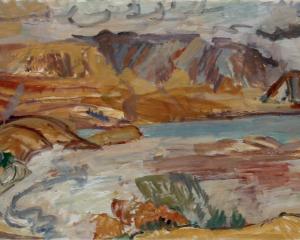Robert Ellis has long been one of New Zealand's pre-eminent painters. In a lengthy career , he has produced many iconic pieces, his hefty, busy works straddling the divide between European and Maori art.
The artist's current Milford exhibition predominantly features two series. In the larger group, the canvas takes the form of geological excavation, seams and slabbed faces creating a land overlaid with text and symbol. The symbols come from the Polynesian end of a bridge between Maori and colonial worlds: Ratana, a specifically antipodean elaboration and extension of introduced religion. The colours of the work, heavy with the earthy red, black, and white of traditional Maori art, also speak of a Pacific bedrock upon which this art is built.
In a second series of works, the same bridge emerges from the European banks of the divide. Its heraldic foundation is built upon with features drawn from Polynesian art and from military decoration. The shields become a distinctly multicultural art form with these features.
The last work in the exhibition is far from the least. The oldest of the pieces, it is one of Ellis' famous semi-abstract ''motorway'' paintings from the 1970s. Amid cloud-like landscapes, the roiling knotted roads produce a forceful impression, and the work dominates the gallery space.
Like Ellis, Shigeyuki Kihara's exhibition at the Hocken examines the point of cultural intersection between Europe and the Pacific.
Of mixed Japanese-Samoan descent, Kihara focuses her attention on the poignant assimilation of European and Pacific cultures. There is a sadness here at failed expectations. Samoa is not the idyllic paradise of European tales. Nor has Europe provided a panacea to the ills of remote island society. Samoa finds itself with a crisis of identity, no longer entirely at home in its Pasifika, the colonial customs which replaced the traditional form an ill-fitting straitjacket.
Kihara excellently portrays these issues in her photographs, photomontages, and videos. The artist uses herself as a model in many pieces, notably the boldly confrontational nude triptych Fa'afafine: In the Manner of a Woman and various works which recapitulate early colonial photographs. She also appears in the subdued melancholia of the post-cyclone, post-tsunami series Where Do We Come From? What Are We? Where Are We Going?, its apt title poignantly restating that of Gauguin's most famous Pacific work.
Three hypnotic multiple-exposure videos of undulating dance hand-movements performed by the artist also add to the display, which is given context and resonance by several cases of historical images of the islands from the gallery's collection.
The annual Otago Wildlife Photography Competition exhibition is always an excellent chance to admire both views of the natural world and the breadth and depth of local photographic talent. In its 14th year, the competition has again thrown up a host of excellent works by both amateur and professional photographers.
The works are divided into three categories (animal, plant, and human impact) . The categories require somewhat different skills and eye; light and pattern play a more decisive part in the plant studies, whereas timing is of major importance with the animal photographs. With the human-impact works, an eye for juxtaposition and irony plays a major part. In all cases, impact is often leavened by wry humour.
Two age groups are represented, and it is good to see that so much of the excellent work is produced by the juniors. This is a sure indication that the art of photography is in safe hands for the future.
The overall standard is very high, and too many works stand out to name more than a representative sample, but the judges' choices of winners (all mentioned in previous editions of this paper) are well chosen. Among other works which draw the eye are Ruby Harris' silhouetted spoonbill, Mike Neumegen's nicely captured ''Surfers'', and Anthea Ibell's split-screen harbour study.









![Untitled (c. mid 1990s, [pink 3]), by Martin Thompson, 415mm×590mm. Photo: courtesy of Brett...](https://www.odt.co.nz/sites/default/files/styles/odt_landscape_small_related_stories/public/story/2024/02/untitled_pink_3.jpg?itok=Q0aQrc9o)


